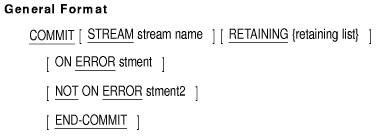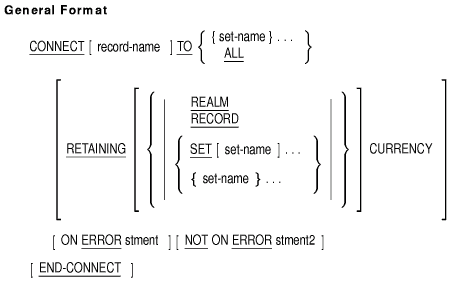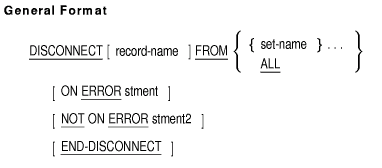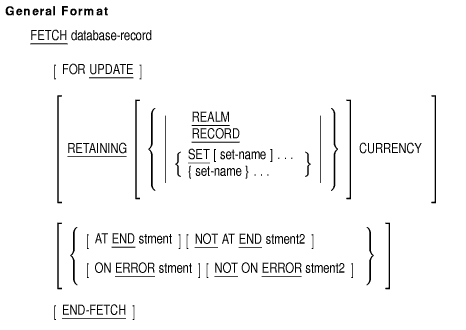Compaq COBOL
DBMS Database Programming Manual
4.8.4 Translating DB-CONDITION Values to Exception Messages
Oracle CODASYL DBMS includes the following procedure for exception condition
handling:
Use this procedure when it is necessary to output an exception message
rather than, or in addition to, displaying the numeric value of
DB-CONDITION. For more information on the Oracle CODASYL DBMS database
special register DB-CONDITION, see Section 2.2.1, DB-CONDITION.
4.9 Database Programming Statements in the COBOL Procedure Division
The Compaq COBOL Oracle CODASYL DBMS DML statements are:
- COMMIT
- CONNECT
- DISCONNECT
- ERASE
- FETCH
- FIND
- FREE
- GET
- KEEP
- MODIFY
- READY
- RECONNECT
- ROLLBACK
- STORE
- USE (Format 3)
- The RETAINING clause
COMMIT
Function
The COMMIT statement ends your database transaction, makes permanent
all changes made to the database since the last quiet point, and
establishes a new quiet point for this run unit.

stment
is an imperative statement executed for an on error condition.
stment2
is an imperative statement executed for a not on error condition.
Syntax Rules
- The STREAM clause cannot be specified if the subschema entry (DB)
does not name a stream.
General Rules
- The COMMIT statement ends the database transaction.
- If you do not specify the STREAM clause, the COMMIT statement makes
all changes made to the database since the last quiet point for this
run unit; a new quiet point is established for the run unit.
- If you specify the STREAM clause, the COMMIT statement makes all
changes made to the database since the last quiet point permanent for
the specified stream; a new quiet point is then established for the
stream.
- If you do not use the RETAINING clause (see Section 4.9.1, RETAINING Clause), COMMIT:
- Empties all keeplists
- Resets all your currency indicators to null
- Releases all realm and record locks
- Makes visible any changes you made to the database
- Terminates the READY mode for each target realm
- If you do use the RETAINING clause, COMMIT:
- Does not empty keeplists
- Retains all currency indicators
- Does not release realm locks
- Demotes no-read record locks to read-only record locks, then
releases locks for all records except those in currency indicators or
keeplists
- Makes visible any changes you made to the database
- Maintains READY modes for each target realm
- If a database exception condition occurs during the execution of a
COMMIT statement, the DBCS places a database exception condition code
in the special register DB-CONDITION. This code identifies the
condition.
Additional References
- Section 2.2 on reserved words (database special registers)
- Compaq COBOL Reference Manual, Chapter 6, section on scope of statements
- Section 4.8.1, on database On Error condition
- USE statement (Format 3)
- Section 5.2.4, on subschema description (DB)
Example
COMMIT ON ERROR PERFORM 200-DISPLAY-ERROR-ON-COMMIT
END-COMMIT.
|
CONNECT
Function
The CONNECT statement inserts the current record of the run unit as a
member record into one or more sets. The set occurrence for each
insertion is determined by the currency indicator for the corresponding
set type.

record-name
names a subschema record type.
set-name
names a subschema set type.
stment
is an imperative statement executed for an on error condition.
stment2
is an imperative statement executed for a not on error condition.
Syntax Rules
- Record-name must reference a subschema record type.
- Set-name must reference a subschema set type.
- For each set-name in the TO set-name clause, the
record type of record-name must be a member record type of the
set type.
- The same set-name cannot be specified more than once in
the TO set-name clause.
- The same set-name cannot be specified more than once in
the RETAINING clause.
General Rules
- The current record of the run unit must be in a realm in ready
update mode and all records required by the Database Control System
(DBCS) to execute the CONNECT statement must be in a realm in available
mode. The CONNECT statement uses the current record of the run unit.
- Use record-name to check that the current record of the
run unit is a record type identical to the record-name record
type.
- The current record of the run unit must not already be a member of
set-name.
- For each set-name in the TO clause:
- The DBCS inserts the current record of the run unit into each
set-name as determined by the set currency indicator
associated with each set-name.
- The position where the DBCS inserts the record into the set is
determined according to the criteria for ordering the set defined in
the schema for set-name.
- When specifying the ALL option:
- The DBCS considers only those set types specified in your subschema
for which:
- The current record is not presently a member of any occurrence of
the set type.
- The record type of the current record is defined in the schema as a
member record type of the set type.
- For each such selected set type:
- The DBCS inserts the current record into the set determined by the
set currency indicator associated with the selected set type.
- The position where the DBCS inserts the current record into the set
is determined according to the set-ordering criteria in the schema for
the selected set type.
- Unless otherwise specified by the RETAINING clause (see
Section 4.9.1, RETAINING Clause), set type currency indicators for the connected sets
point to the connected record. All other currency indicators are not
affected.
- If a database exception condition occurs during the execution of a
CONNECT statement, the DBCS places a database exception condition code
in the special register DB-CONDITION (see Technical Notes). This code
identifies the condition.
- If the execution of a CONNECT statement results in a database
exception condition, no changes are made to the membership of the
current record in the database.
Technical Notes
CONNECT statement execution can result in these DB-CONDITION database
exception condition codes:
|
DBM$_CRUN_NULL
|
The currency indicator for the run unit is null.
|
|
DBM$_CRUN_POS
|
The currency indicator for the run unit specifies the position of a
vacated record in a record collection.
|
|
DBM$_WRONGRTYP
|
The record type of
record-name is not the same as the current record's type.
|
|
DBM$_NOT_MTYP
|
The current record is not a member record type of a set in the TO
set-name phrase.
|
|
DBM$_NOW_MBR
|
The current record is already a member of the set specified in the TO
set-name phrase.
|
|
DBM$_CSTYP_NULL
|
There is no current of set type for the set specified in the TO
set-name phrase. This occurs only if the set is not a singular
set.
|
|
DBM$_DUPNOTALL
|
The program attempts to connect a record to a set and its sort key
value is identical to another record's sort key value already in the
set.
|
|
DBM$_NOT_UPDATE
|
A realm is not in update usage mode.
|
|
DBM$_CHKMEMBER
|
The Oracle CODASYL DBMS CHECK (member) condition was evaluated to be false.
The database remains unchanged.
|
Additional References
- Section 2.2 on reserved words (database special registers)
- Compaq COBOL Reference Manual, Chapter 6, section on scope of statements
- Section 4.8.1, on database On Error condition
- Section 5.14.1, on RETAINING clause
- USE statement
Examples
- Connecting EMPLOYEE record to the CONSISTS_OF set:
CONNECT EMPLOYEE TO CONSISTS_OF.
|
- Connecting EMPLOYEE record to all sets:
- Connecting EMPLOYEE record to the CONSISTS_OF set without changing
the currency indicator of the CONSISTS_OF set:
CONNECT EMPLOYEE TO CONSISTS_OF
RETAINING SET CONSISTS_OF CURRENCY.
|
DISCONNECT
Function
The DISCONNECT statement logically removes the current record of the
run unit from one or more sets.

record-name
names a subschema record type.
set-name
names a subschema set type.
stment
is an imperative statement executed for an on error condition.
stment2
is an imperative statement executed for a not on error condition.
Syntax Rules
- The record type of record-name must be a member record
type of the set type for each set-name.
- The same set-name cannot be specified more than once in
the same DISCONNECT statement.
General Rules
- The DISCONNECT statement references the current record of the run
unit.
- The current record of the run unit must be in a realm in ready mode
and all records required by the DBCS to execute the DISCONNECT
statement must be in a realm in available mode.
- Use record-name to check that the current record of the
run unit has the same record type as record-name.
- The current record of the run unit must be an OPTIONAL member of
each set-name.
- The record type of the current record of the run unit must be a
member record type of the set type for each set-name.
- The DBCS removes the current record of the run unit from each
set-name.
- Use the ALL clause to remove the current record of the run unit
from as many sets as possible. The DBCS considers only those set types
defined in the subschema for which the record is an OPTIONAL member.
Set types not included in your subschema and set types of which the
record is not a member are ignored. The current record of the run unit
is removed from each remaining set type.
- If the set type currency indicator for a disconnected set pointed
to the current record, that currency indicator now points to the
position in the set vacated by the record. All other currency
indicators are not affected.
- If the execution of a DISCONNECT statement results in a database
exception condition, no changes are made to the membership of the
current record in the database.
- If a database exception condition occurs during the execution of a
DISCONNECT statement, the DBCS places a database exception condition
code in the special register DB-CONDITION (see Technical Notes). This
code identifies the condition.
Technical Notes
DISCONNECT statement execution can result in these DB-CONDITION
database exception condition codes:
|
DBM$_NOT_OPTNL
|
The current record of the run unit is not an OPTIONAL member of
set-name.
|
|
DBM$_CRUN_NULL
|
The currency indicator for the current record of the run unit is null.
|
|
DBM$_CRUN_POS
|
The currency indicator for the current record of the run unit specifies
the position of a vacated record in a record collection.
|
|
DBM$_WRONGRTYP
|
The record type of record-name is not the same as the current record's
type.
|
|
DBM$_NOT_MTYP
|
The current record is not a member record type of set-name.
|
|
DBM$_NOT_MBR
|
The current record is not a member of set-name.
|
|
DBM$_NOT_UPDATE
|
A realm is not in ready update usage mode.
|
Additional References
- Section 2.2 on reserved words (database special registers)
- Compaq COBOL Reference Manual, Chapter 6, section on scope of statements
- Section 4.8.1, on database On Error condition
- USE statement
Examples
DISCONNECT EMPLOYEE FROM CONSISTS_OF.
DISCONNECT EMPLOYEE FROM ALL.
DISCONNECT FROM ALL.
DISCONNECT FROM CONSISTS_OF.
|
ERASE
Function
The ERASE statement deletes the current record of the run unit from the
database. Additional records owned by the current record may also be
deleted and/or disconnected.

record-name
names a subschema record type.
stment
is an imperative statement executed for an on error condition.
stment2
is an imperative statement executed for a not on error condition.
General Rules
- The ERASE statement references the current record of the run unit.
- Use record-name to check that the current record of the
run unit has the same record type as record-name.
- The current record of the run unit must be in a realm in update
ready mode, and all records required by the Database Control System
(DBCS) to execute the ERASE statement must be in a realm in available
mode.
- The current record of the run unit is called the object
record for the remaining General Rules.
- The object record is erased from all sets in which it is a member
and deleted from the database.
- If you use the ALL phrase, the object record and all sets owned by
the object record are erased (independent of set membership retention
class).
- If you do not use the ALL phrase, these rules apply to the members
of the sets owned by the erased object record:
- Each member with FIXED membership is erased.
- Each member with OPTIONAL membership is disconnected from the set
but not deleted from the database.
- An exception occurs if any members have MANDATORY membership.
- The database key value corresponding to the erased object record is
removed from all keeplists.
- General Rules 5 to 8 apply to each erased record as if it were the
object record.
- The successful ERASE statement changes currency indicators as
follows:
- The currency indicator for the current record of the run unit
points to the position in the database vacated by the current record of
the run unit. However, you no longer have a current record.
- If an erased record is the current record of a disconnected set
type, that set type currency indicator now points to the position in
the set vacated by that record.
- If an erased record is the owner of the current set of any set
type, that set type's currency indicator becomes null.
- If an erased record is the current record of a record type, that
record type currency indicator becomes null.
- If the erased record is the current record of the realm, that realm
currency indicator now points to the position in the realm vacated by
that record.
- If the execution of an ERASE statement results in a database
exception condition, no changes are made to the database.
- If a database exception condition occurs during the execution of an
ERASE statement, the DBCS places a database exception condition code in
the special register DB-CONDITION (see Technical Notes). This code
identifies the condition.
Technical Notes
ERASE statement execution can result in these DB-CONDITION database
exception condition codes:
|
DBM$_CRUN_NULL
|
The currency indicator for the run unit is null.
|
|
DBM$_CRUN_POS
|
The currency indicator for the run unit specifies the position of a
vacated record in the record collection.
|
|
DBM$_WRONGRTYP
|
The record type of record-name is not the same as the current record's
type.
|
|
DBM$_ERASEMANDT
|
You attempted to erase a record that is the owner of a set occurrence
with a MANDATORY member record occurrence, but you did not use the ALL
option.
|
|
DBM$_NOT_UPDATE
|
A realm is not in update usage mode.
|
Additional References
- Section 2.2, on reserved words (database special registers)
- Compaq COBOL Reference Manual, Chapter 6, section on scope of statements
- Section 4.8.1, on database On Error condition
- USE statement
Examples
- This example erases PART record, all records owned by PART in the
PART_USES, PART_INFO, and PART_USED_ON sets. It also erases all SUPPLY
and PR_QUOTE records that it owns through the PART_INFO set. It
disconnects PART from the RESPONSIBLE_FOR set.
- This example has the same effect as in example 1 for each PART
record that the CLASS1 record owns; however, it also erases the CLASS1
record.
Note
Because CLASS1 has MANDATORY members, you cannot erase only
CLASS1.
|
FETCH
Function
The FETCH statement is a combined FIND and GET that establishes a
specific record in the database as the current record of the run unit
and makes the record available to the run unit in the user work area.

database-record
represents a record selection expression. References are made to a
record in the database according to the rules for Record Selection
Expressions (see Section 4.6).
set-name
names a subschema set type.
stment
is an imperative statement executed for an AT END or ON ERROR condition.
stment2
is an imperative statement executed for a NOT AT END or NOT ON ERROR
condition.
General Rules
- database-record must reference a record stored in a realm
that is in ready mode.
- The FETCH statement is equivalent to the following sequence of
statements:
FIND database-record...
GET...
- Execution of the FETCH statement causes database-record to
become the current record of the run unit.
- The FOR UPDATE option puts a no-read lock on the specified record.
- The DBCS makes a copy of the selected database record available to
the program in the user work area. Any change made to the user work
area does not affect the record in the database. You must execute a
MODIFY and COMMIT statement to make permanent changes to the database.
- Unless otherwise specified by the RETAINING clause (see
Section 4.9.1, RETAINING Clause), the successful FETCH statement causes the DBCS to
update these currency indicators to point to the selected record:
- Run unit.
- Realm.
- Record type.
- Set type. If it is an owner record type of the set type, this
currency indicator points to the selected record even if the set is
empty. If it is a member record type of the set type, this currency
indicator points to the selected record only if it is currently a
member of some set of that record type.
- The DBCS places the database key of the fetched record in the
special register DB-KEY.
- If a database exception condition occurs during the execution of a
FETCH statement, the DBCS places a database exception condition code in
the special register DB-CONDITION (see Technical Note). This code
identifies the condition.
- [NOT]ON ERROR and [NOT]AT END cannot be used concurrently in a
Fetch statement.
- If either AT END or ON ERROR is used, it must precede USE.
- If ON ERROR and NOT ON ERROR are used concurrently in a Fetch
statement, USE procedures will not be activated.
Technical Note
FETCH statement execution can result in these database exception
conditions and those associated with the evaluation of the record
selection expression:
|
DBM$_CONVERR
|
A data conversion error occurred in the FETCH operation.
|
|
DBM$_ILLNCHAR
|
Invalid character found in a numeric field.
|
|
DBM$_NONDIGIT
|
Nonnumeric character found in a numeric field.
|
|
DBM$_OVERFLOW
|
A data overflow error occurred in the FETCH operation.
|
|
DBM$_TRUNCATION
|
A data truncation error occurred in the FETCH operation.
|
|
DBM$_UNDERFLOW
|
A data underflow error occurred in the FETCH operation.
|
Additional References
- Section 2.2, on reserved words (database special registers)
- Compaq COBOL Reference Manual, Chapter 6, section on scope of statements
- Section 4.6, on record selection expressions
- Compaq COBOL Reference Manual, Chapter 6, section on AT END phrase
- Section 4.8.1, on database On Error condition
- Section 5.14.1, on RETAINING clause
- USE statement
Examples
- Currency indicator access. To retrieve the:
- Current record of the run unit
- Current record of the MAKE realm
FETCH CURRENT WITHIN MAKE.
|
- Current record of the CLASS_PART set
FETCH CURRENT WITHIN CLASS_PART.
|
- Current PART record
FETCH CURRENT WITHIN PART.
|
- Keeplist access. To retrieve the:
- First entry in the keeplist
FETCH FIRST WITHIN KEEPLIST-A.
|
- Last entry in the keeplist
FETCH LAST WITHIN KEEPLIST-B.
|
- N(th) entry in the keeplist
FETCH OFFSET RECORD-COUNT WITHIN KEEPLIST-C.
|
- Set owner access. To retrieve the owner (PART) of the PART_USES set:
FETCH OWNER WITHIN PART_USES.
|
- Record search access. To retrieve the:
- First member within the PART_USES set
FETCH FIRST WITHIN PART_USES.
|
- First part whose PART-COST is greater than 300 dollars
FETCH FIRST PART WHERE PARTCOST GREATER THAN 300
|
- Last member within the BUY realm
- Next COMPONENT record in the PART_USED_ON set
FETCH NEXT COMPONENT WITHIN PART_USED_ON.
|
- Prior COMPONENT record in the PART_USES set using COMP_SUB_PART and
COMP_OWNER_PART as record keys
FETCH PRIOR COMPONENT WITHIN PART_USES
USING COMP_SUB_PART, COMP_OWNER_PART.
|
- Record relative to the current record, this statement starts from
the current position to the position defined by this offset
FETCH RELATIVE SEARCH-NUMBER
ON ERROR PERFORM 300-FETCH-IN-ERROR-ROUTINE
END-FETCH.
|
- PART record with PART_STATUS equal to "G" from the
CLASS_PART set
MOVE "G" TO PART_STATUS.
FETCH NEXT CLASS WITHIN ALL_CLASS.
FETCH NEXT PART WITHIN CLASS_PART USING PART_STATUS
AT END ...
|
- DB-KEY access. To retrieve the item referred to by the DB-KEY
special register:




